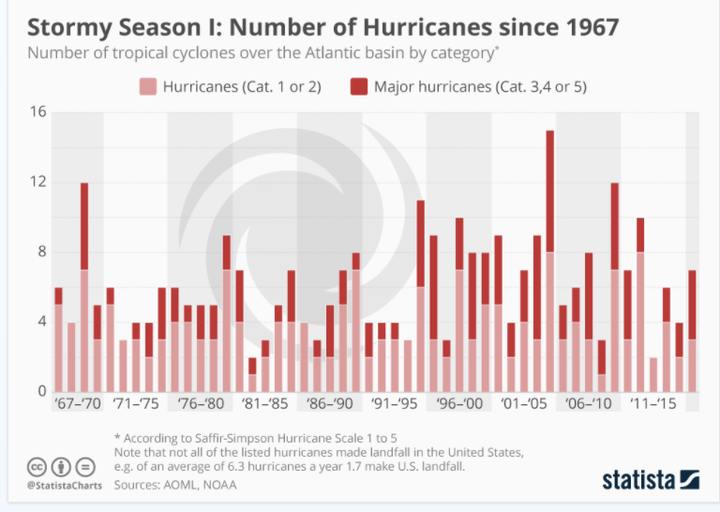
While global climate change is not expected to increase the number of hurricanes, it is expected to increase their severity. This chart shows the number of hurricanes in the Atlantic basin since 1967. The dark red bars indicate hurricane strengths. They generally show that Category 3-5 hurricanes have been more frequent in recent years.
If climate scientists around the world had less class, they would be bombarding the White House switchboard with “We told you so” messages right now. Presidents and members of Congress who could do something meaningful about climate change have been warned for decades that inaction would condemn us to a future of brutal weather. That future is upon us. The same scientists who warned us it was coming say it will get much worse.
Tragically, our current federal government is in the control not only of climate deniers, but also public officials who have sold their souls to America’s carbon cartel. Climate change is not the only environmental issue being neglected. There are nearly 180 environmental protection bills pending in Congress. Oddsmakers figure the bill most likely to succeed has only a 36 percent chance of passage. The prognosis for passage of most of the other bills is less than 10 percent.
In the Trump Administration, the problem isn’t merely the denial of reality. It is a Chief Executive and Cabinet that are hell-bent on eviscerating the federal government’s capacity to understand global warming, to anticipate its consequences and to help citizens deal with it.
So, who are the victims of federal government inaction? They are the people killed, displaced or dispossessed by these disasters, of course. But we are already seeing another casualty: Congress’s ability to keep federal spending and taxpayer burdens under control. Unless Congress decides it has no obligation to help disaster victims or unless it figures out how to outlaw storms, fires and droughts, the fiscal demands of these disasters will bleed resources from other very important federal obligations.
If this seems like leftist balderdash, let’s review what’s happening with the weather in the United States right now.
When 2017 began, it took only three months for the United States to be hit by five separate billion-dollar disasters – the most of that magnitude for the first quarter of any year on record. Extreme rains caused flooding in Missouri, Oklahoma, Arkansas and southern Illinois. In addition to property losses, farmers lost crops and infrastructure was damaged. Our most recent disaster for the moment, Hurricane Harvey, is the 10th billion-dollar calamity this year and the most expensive weather event in the nation’s history.
Northeastern states began experiencing record heat waves even before summer officially began. In Western states, temperatures have been reaching extremes never seen since recordkeeping started. In downtown San Francisco, for example, the heat reached 106 degrees last Friday in the midst of the most severe statewide heat wave ever observed. Reno suffered its 14th hundred-degree day over last weekend, breaking a record set in 1937. This has been the hottest summer on record in 15 Western cities, according to weather historian Christopher Burt.
While Harvey was drowning Houston and other Gulf Coast cities, more than 25,000 firefighters and support personnel were combatting nearly 70 uncontained wildfires in the West. Winds blew a thick haze of smoke into several other states, triggering air quality alerts.
When it left the Gulf Coast, Harvey went on to cause flash flooding in Arkansas, Tennessee and Kentucky. As I write this, Florida is preparing for Hurricane Irma, this year’s eleventh billion-dollar calamity and one of strongest storms ever recorded.
How has Trump responded? In the 2018 budget proposal he released in May, he called for a $1 billion reduction in FEMA’s budget to help finance his border wall. It was nearly half of the money available in federal disaster funds. Meantime, the Federal Flood Insurance Program remains $25 billion in the red.
In 2016, Columbia University published findings that human-induced climate change over the last 30 years has doubled the area vulnerable to forest fires in the West. Nevertheless, Trump proposed cutting $300 million from the U.S. Forest Service’s already strapped firefighting budget and $50 million from its wildfire prevention program.
The opponents of climate action argue that mitigating climate change would ruin the economy. Yet for at least a decade, probably more, climate scientists and economists have emphasized that if climate change is ignored, the costs to lives, property and government budgets would be much higher than the cost of mitigation.
In 2006, British economist Lord Nicholas Stern issued one of the first definitive estimates. He calculated that unless the world invested about 1% of GDP on climate action, climate impacts could cost nations 20% of global GDP or more. Ten years later after observing some of the impacts of climate change, Stern said “With hindsight, I now realize that I underestimated the risks. I should have been much stronger in what I said in the report about the costs of inaction. I underplayed the dangers.”
In 2014, the Obama White House warned that delaying action on global warming would result in a 40% increase in economic losses over 10 years. Two years ago, after five years of study and extensive peer review, Obama’s EPA concluded that every region of the U.S. is vulnerable to economic losses from climate impacts. EPA estimated that without action, nationwide losses would climb to hundreds of billions of dollars.
On the plus side, Obama’s EPA projected that the international effort to reduce greenhouse gas emissions would save a lot of lives and money in the United States. An overwhelming majority of economists with climate expertise agreed. Surveyed last year by New York University (NYU), 95% of experts on the economics of climate change said the United States should follow through on the pledges the Obama Administration made in the Paris climate agreement. NYU economists have calculated that the climate policies of other nations have already benefited the U.S. economy by more than $200 billion, and the pledges other nations have made in the Paris climate accord could save the United States more than $2 trillion by 2030 and more than $10 trillion by 2050.
Trump’s response was to pull the United States out of the Paris agreement.
While many states and cities have stepped up and pledged to keep America’s promise in the Paris pact, there is no timely or ubiquitous substitute for federal action like a national price on carbon, an end to taxpayer subsidies for fossil fuels, or a space program designed to learn more about global warming and its impacts.
The tragic reality is that we may already be too late to prevent catastrophic weather patterns from becoming the norm in America and around the world. The political disaster behind these weather disasters is the total disregard many of our leaders have displayed about one of the most serious threats to world stability and personal safety.
If there must be more wildfires, floods and droughts in the United States and elsewhere, let’s hope the next victim is climate change denial.
